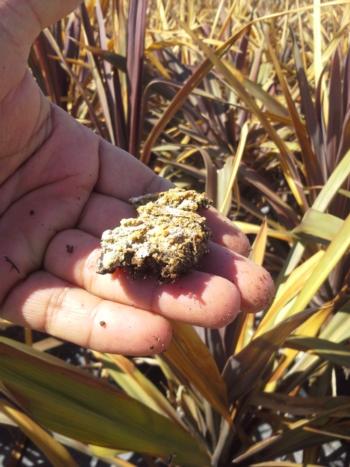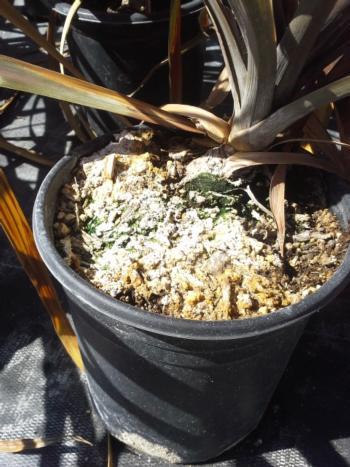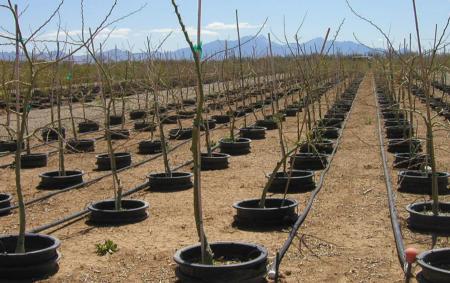GET CULTURED: Horticultural practices to conserve water and mitigate salt precipitation in container production
by Donald J. Merhaut
This is the second in a series of “Get Cultured” articles on reclaimed water in nursery production. In the previous newsletter, we discussed various chemical traits that render challenge in using reclaimed water in nursery production. In this article, we will elaborate on horticultural practices and cultural care options to minimize the negative impact of poor quality irrigation water on plant production. Even though water treatments such as filtration techniques and blending water are viable options, this article will focus only on horticultural and cultural methods. Fortunately, the recommendations that follow will also help reduce water usage.
Irrigation of containerized plants serves four primary functions: (1) provides water directly for plant uptake and transpiration, (2) provides dissolved fertilizers in the water to supply plants with essential nutrients, (3) facilitates the application of some pesticides via the irrigation system, and (4) maintains relatively high humidity for propagation facilities.
Horticultural practices and other cultural recommendations are often based on the assumption that the water being used is fairly good for plant production. These “good” traits include ideal pH, low alkalinity, low electrical conductivity (EC) and nonharmful levels of salts such as sodium, chloride and heavy metals. Unfortunately, the quality of reclaimed water is often poor and requires treatment prior to use or the implementation of cultural practices to ensure that irrigation is effective in carrying out the functions listed above. Options include:
- Removing harmful impurities. The quality of reclaimed water can be improved by cleaning the water source of the harmful impurities that are present using filtration techniques such as reverse osmosis. Filtration has been addressed in previous issues, and we may need to address this again in future issues. Filtration may be the only option for propagation facilities, where misters and foggers are used and the propagative material is often very sensitive to these impurities. Calcium salts can build up on foliage and clog the tiny orifices on irrigation emitters.
- Blending. Another option for improving water quality is to blend the lower-quality water (reclaimed or other secondary water sources) with a clean water source in a ratio that reduces the harmful salts to non-toxic concentrations. This method is ideal if better water sources are available. However, in some areas of California, only reclaimed water is available for some facilities.
- Adjusting cultural practices. A variety of cultural management practices can be implemented to reduce the negative effects of poor quality reclaimed water when good quality water is not available for blending. These practices are the primary focus of this article and are described below.
Reduce Water-Holding Capacity
Since some reclaimed water sources have a high EC, that is, high concentrations of dissolved essential and non-essential salts, it will be important to have a medium that is hydrophilic (“water-loving”), yet very well drained. Traditionally, media containing peatmoss or coir, which have high water-holding capacity (WHC), have been favored since this allows for extended periods between irrigation episodes. However, in the case of water sources with high salinity, the objective of irrigation is to provide water to the plants, but have most of the water leach through the containers. The logic behind this practice is that the dissolved salts in the irrigation water will remain in the pots if high WHC-type media are used. As the medium dries, the volume of water decreases, but the salt in the water becomes more concentrated, and eventually precipitates (fig. 1), which can damage root systems.

Fig. 1. Precipitation of salts on the surface of a planting mix. Electrical Conductivity (EC) of 16 dS/m has been observed in some situations, which will kill roots of most plant species. Photo: D. Merhaut.
For example, if a grower has irrigation water with an EC of 3.0 dS/m, and a 2-gallon pot holds 1 liter of irrigation water, as the water evaporates to 0.5 liter, the salt levels can become approximately twice as high, about 6.0 dS/m. While 3.0 dS/m is tolerable for many crops, 6.0 dS/m will cause damage to many crops, especially if this scenario is not corrected.
Mitigate Water Wicking
Unfortunately, the medium within a container does not dry out uniformly. The southwest side of a container will dry out faster than the northeast side. Similarly, if a portion of the pot is shaded by the plant, the evaporative wicking of moisture from the pot surface will occur on the sunny portion (fig. 2), and this is where the salts will precipitate and accumulate.

Fig. 2. Precipitation of salts on the sunny, southwest side of a container. Salt precipitation is essentially nonexistent on the shaded right side of the container. Photo: D. Merhaut.
Likewise, within a bed of containerized plants, pots that are on the outside of the southwest portion (sunny side) of the planting block will dry out faster and have greater wicking of moisture and precipitation of salts on the sides and the surface of the pots than pots located within the bed or on the northeast side of the bed. Wicking of moisture and accumulation of salts, as well as high temperatures, can be a problem, even when good water sources are used.
Pot-in-pot production. Cultural practices that mitigate wicking and salt accumulation include using the pot-in-pot system, in which holder pots (socket pots, moat pots) are buried in the ground and the containerized plants are placed inside these pots (fig. 3). This system reduces the heating of the containers by the sun since they are shaded by the larger holder pots. Additionally, temperatures in the root zone are moderated because of the insulation from the soil. Also, once the plant material grows and shades the pot surfaces, the high loss of moisture at the medium surface will be reduced. Depending on the severity of the problem, the pot-in-pot method may only be necessary on the southwest side of a production bed.

Fig. 3. Trees in a pot-in-pot system in which containerized plants are placed in larger holder pots installed in the ground. Temperatures in the root zone are moderated because the holder pots shade the smaller containers and the soil around the containers provides insulation. Photo: U.K. Schuch.
Shading. Another method that maintains temperature uniformity and mitigates wicking in the container is shading. This is a good cultural practice, since it will also avoid excessive moisture loss, reducing heat and water stress of newly planted crops which have tender young shoot growth and have not established an extensive root system. Once the plants have developed and have “hardened off,” they can be transitioned to their permanent production site. In hotter climates of the interior valleys, some degree of shade may be ideal, especially during the summer months.
- Windbreaks can be provided in the form of fencing, trees, hedges or even larger plants, such as 24-inch boxed trees, with the smaller containers in between. In addition to reducing water loss, windbreaks provide shade, where trees are large enough, that can help mitigate wicking. These types of cultural practices need to be carefully thought out, since irrigation systems, pest management and other cultural practices will need to be met for the two different plant types in the same growing area.
Drip vs. Overhead Irrigation
The proper use of drip irrigation does improve water use efficiency in the crop and eliminates the potential of water marks forming on the leaves, which can occur with overhead irrigation. However, there is increased risk of salt accumulation in the containers since water is slowly released into the container. Another concern with drip irrigation is that the small openings of the emitters are more likely to clog than the larger openings present in overhead irrigation systems. Careful selection and maintenance of irrigation nozzles will be important to optimize efficiency of irrigation programs.
Record Keeping
As with any crop production program, keeping track of salt accumulation in containers should be regularly monitored, especially during the summer. Methods of measurement include pour-through and soil-water extraction methods. However, more important than the method used, is that the same method is used so that results from past tests can be compared to future tests.
Fertilizer Use
In the next issue, we will address fertilizer selection, use, storage and other aspects of plant nutrition which may be affected by secondary water sources such as reclaimed water.
Don Merhaut is a UC Cooperative Extension Specialist for Nursery and Floriculture Crops, Department of Botany and Plant Sciences, UC Riverside.












